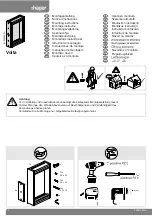
Chapter 5
Setup and Configuration
RUGGEDCOM ROX II
User Guide
756
Enabling and Configuring Traffic Control
NOTE
For more information about firewalls, refer to
Section 5.17, “Managing Firewalls”
ROX II allows up to 4 different firewall configurations, enabling users to quickly change between configurations.
Users can quickly assess different configurations without needing to save and reload any part of the
configuration. In contrast, there is only one traffic control configuration. When enabled, a traffic control
configuration is used with the current firewall configuration. A current firewall configuration is defined as one that
is specified in either work-config and/or active-config. It does not have to be enabled to be validated.
NOTE
Traffic control is not available for Ethernet traffic on any line module when Layer 3 hardware
acceleration is enabled. It is intended to be used only on WAN interfaces.
The following sections describe how to configure and manage traffic control settings:
•
Section 5.37.1, “Enabling and Configuring Traffic Control”
•
Section 5.37.2, “Managing Traffic Control Interfaces”
•
Section 5.37.3, “Managing Traffic Control Priorities”
•
Section 5.37.4, “Managing Traffic Control Classes”
•
Section 5.37.5, “Managing Traffic Control Devices”
•
Section 5.37.6, “Managing Traffic Control Rules”
•
Section 5.37.7, “Managing QoS Mapping for VLANs”
•
Section 5.37.8, “Managing Egress Markers for QoS Maps”
•
Section 5.37.9, “Viewing QoS Statistics”
Section 5.37.1
Enabling and Configuring Traffic Control
Traffic control functions are divided into two modes:
•
Basic Mode
Basic mode offers a limited set of options and parameters. Use this mode to set the outgoing bandwidth for
an interface, the interface priority (high, medium or low), and some simple traffic control characteristics. Basic
traffic shaping affects traffic identified by protocol, port number, address and interface. Note that some of these
options are mutually exclusive. Refer to the information given for each option.
In basic mode, a packet is categorized based on the contents of its Type of Service (ToS) field if it does not
match any of the defined classes.
•
Advanced Mode
In advanced mode, each interface to be managed is assigned a total bandwidth for incoming and outgoing
traffic. Classes are then defined for each interface, each with its own minimum assured bandwidth and a
maximum permitted bandwidth. The combined minimum of the classes on an interface must be no more
than the total outbound bandwidth specified for the interface. Each class is also assigned a priority, and any
bandwidth left over after each class has received its minimum allocation (if needed) will be allocated to the
lowest priority class up until it reaches its maximum bandwidth, after which the next priority is allocated more
bandwidth. When the specified total bandwidth for the interface is reached, no further packets are sent, and
any further packets may be dropped if the interface queues are full.
Summary of Contents for RUGGEDCOM RX1510
Page 32: ...RUGGEDCOM ROX II User Guide Preface Customer Support xxxii ...
Page 44: ...RUGGEDCOM ROX II User Guide Chapter 1 Introduction User Permissions 12 ...
Page 62: ...RUGGEDCOM ROX II User Guide Chapter 2 Using ROX II Using the Command Line Interface 30 ...
Page 268: ...RUGGEDCOM ROX II User Guide Chapter 4 System Administration Deleting a Scheduled Job 236 ...
















































